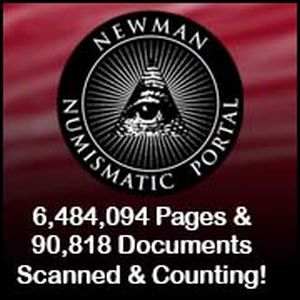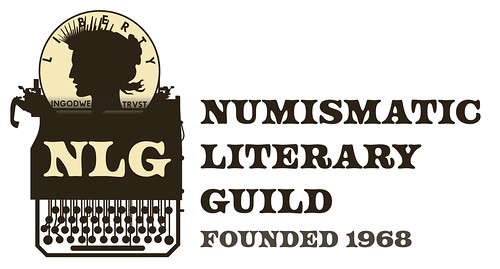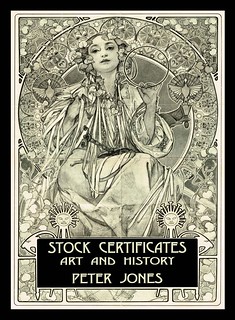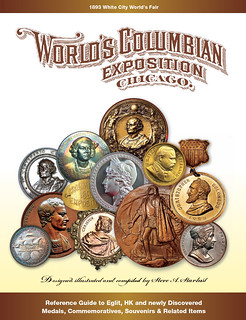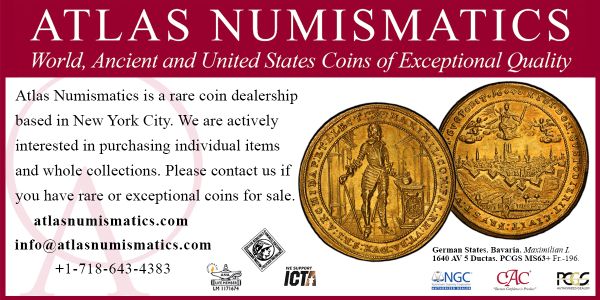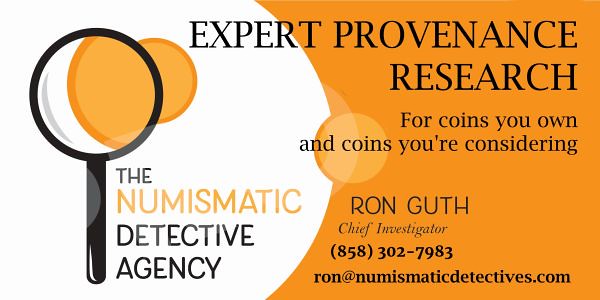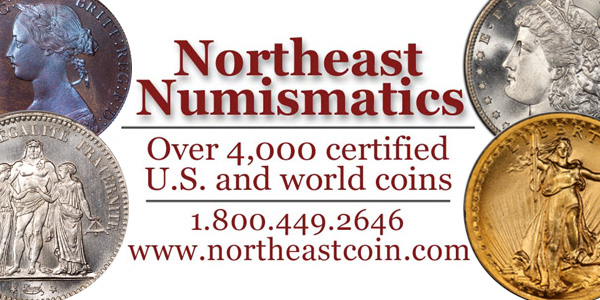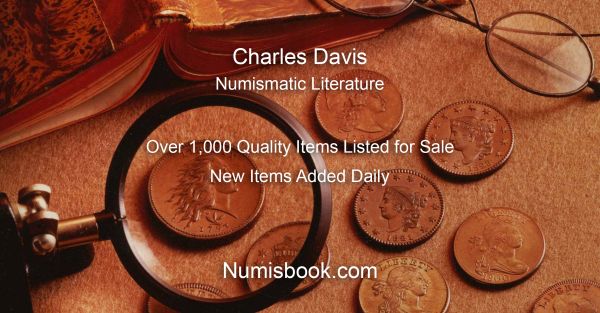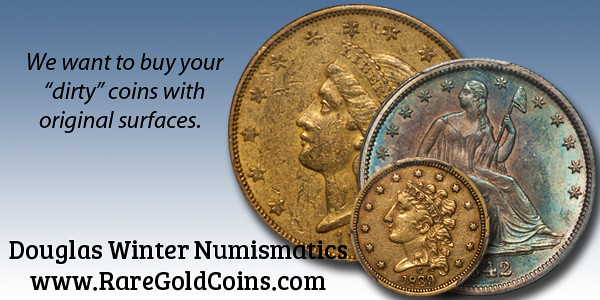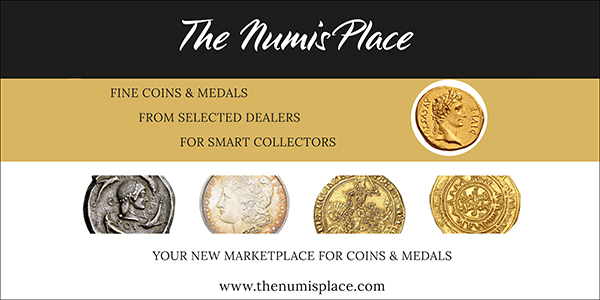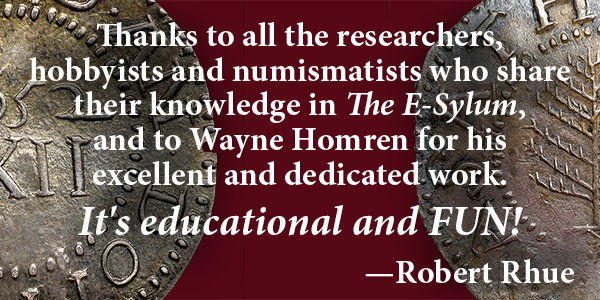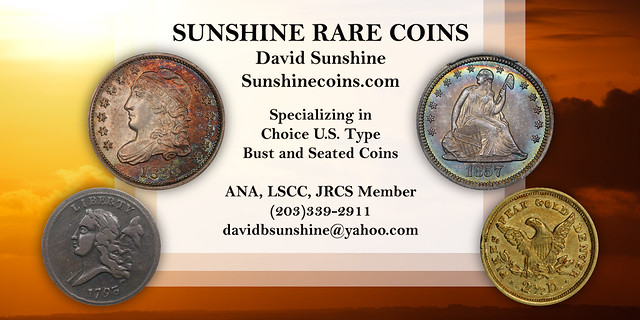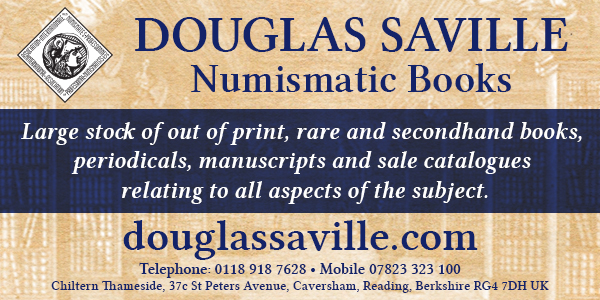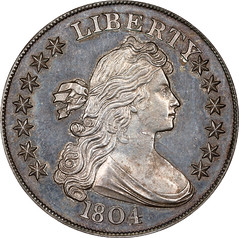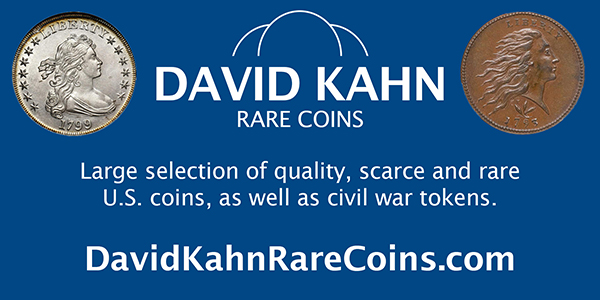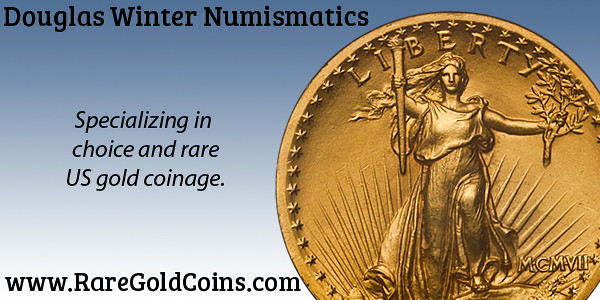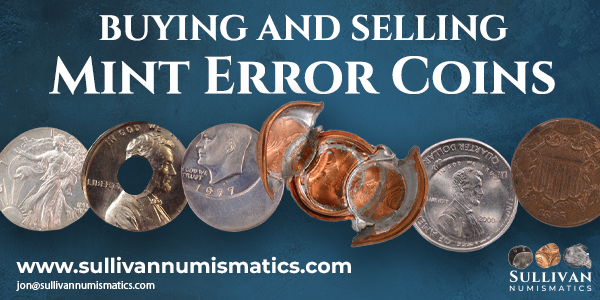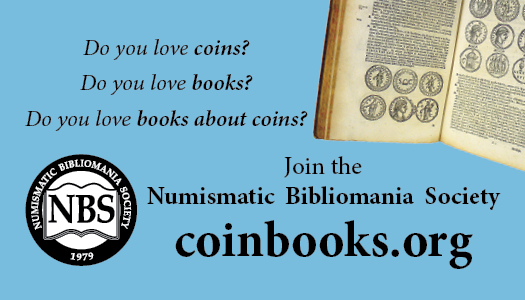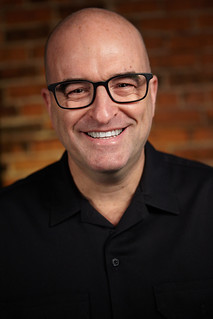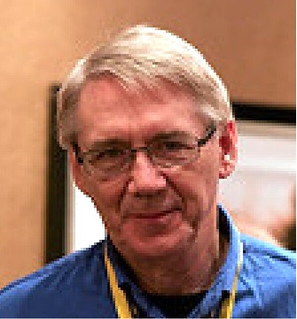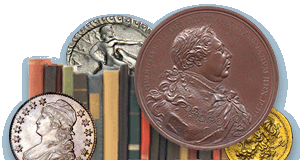
Visit our NBS Sponsors
About UsThe Numismatic Bibliomania Society is a non-profit association devoted to the study and enjoyment of numismatic literature. For more information please see our web site at coinbooks.org SubscriptionsThose wishing to become new E-Sylum subscribers can go to the following web page Subscribe MembershipThere is a membership application available on the web site Membership Application To join, print the application and return it with your check to the address printed on the application. Print/Digital membership is $40 to addresses in the U.S., and $60 elsewhere. A digital-only membership is available for $25. For those without web access, write to: Jeff Dickerson, Treasurer AsylumFor Asylum mailing address changes and other membership questions, contact Jeff at this email address: treasurer@coinbooks.org SubmissionsTo submit items for publication in The E-Sylum, write to the Editor at this address: whomren@gmail.com BUY THE BOOK BEFORE THE COINSale CalendarWatch here for updates! |
- WAYNE'S WORDS: THE E-SYLUM AUGUST 31, 2025
- THE E-SYLUM TURNS TWENTY-SEVEN
- 2025 NUMISMATIC LITERARY GUILD AWARDS
- NEW BOOK: THE BUDDHAPADA TYPE GOLD COINS
- NNP ADDS SAN FRANCISCO MINT NOTEBOOK
- VIDEO: GREAT NUMISMATISTS QDB MET
- ON AI IN NUMISMATIC PUBLISHING
- NOTES FROM E-SYLUM READERS: AUGUST 31, 2025
- JEFF GARRETT: OKLAHOMA CITY GAMBLE PAYS OFF
- SEPTEMBER 2025 GREAT AMERICAN SHOW
- VOCABULARY TERM: RIPPLED SURFACE
- COIN WORLD – A TALE OF TWO ISSUES
- HUNTER HICKS PROFILED IN UVA TODAY
- ON THE PROVENANCE OF THE 16TH 1804 DOLLAR
- ATLAS NUMISMATICS SELECTIONS: AUGUST 31, 2025
- 1935 GEORGE V SILVER JUBILEE CROWN IN GOLD
- KUENKER AUCTION SALE 427
- EGYPTIAN QUEEN BERENICE COIN FOUND
- WHITHER SQUISHED PENNIES?
- US MINT ISSUES FIRST LASER-ENGRAVED COIN
- FALKLAND ISLANDS BANKNOTES TO SHOW KING CHARLES III
- SRI LANKA NOTE FOR THE VISUALLY IMPAIRED
- LOOSE CHANGE: AUGUST 31, 2025
- CHICAGO-AREA U.S. TYPE COIN TREASURE HUNT
- ABOUT THIS ISSUE: AUGUST 31, 2025
Content presented in The E-Sylum is not necessarily researched or independently fact-checked, and views expressed do not necessarily represent those of the Numismatic Bibliomania Society.
WAYNE'S WORDS: THE E-SYLUM AUGUST 31, 2025
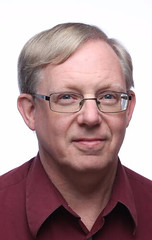 New subscribers this week include:
Jarrod Ranney.
Welcome aboard! We now have 7,031 subscribers.
New subscribers this week include:
Jarrod Ranney.
Welcome aboard! We now have 7,031 subscribers.
Thank you for reading The E-Sylum. If you enjoy it, please send me the email addresses of friends you think may enjoy it as well and I'll send them a subscription. Contact me at whomren@gmail.com anytime regarding your subscription, or questions, comments or suggestions about our content.
Taking a cue from Emeril Lagasse, longtime supporter Douglas Winter Numismatics is kicking it up a notch by becoming a Sponsor. Thank you! His new banner debuts atop this issue.
This week we open with our little birthday party, the 2025 NLG Awards, one new book, updates from the Newman Numismatic Portal, notes from readers and more.
Other topics this week include San Francisco Mint Melter & Refiner Edwin R. Leach, artificial intelligence in numismatic publishing, the Oklahoma city ANA, rippled surfaces, Hunter Hicks, the provenance of the 16th Fantastic 1804 Dollar, fixed price and auction previews, elongated cents, Falkland islands and Sri Lankan banknotes, and a coin treasure hunt.
To learn more about Korean Coins at the U.S. Mint, the Washington Cents, The Ribbit, "Nickel Working", numismatic newshounds, Snowden, Linderman, Woodin, Edgar Adams, the 1935 George V Silver Jubilee Crown in gold, numisnautics, and the penny presser at the Ohio State Reformatory, read on. Have a great week, everyone!
Wayne Homren
Editor, The E-Sylum
THE E-SYLUM TURNS TWENTY-SEVEN
 The E-Sylum is twenty-seven years old this week.
On September 4, 1998 the first issue of what we now call The E-Sylum was emailed to a list of members and friends of the Numismatic Bibliomania Society. Now archived on our web site as Volume 1, Number 1, that first message started the ball rolling. That email went to 49 people. As the word spread, subscription requests arrived from around the world and by September 15 there were 90 subscribers.
The E-Sylum is twenty-seven years old this week.
On September 4, 1998 the first issue of what we now call The E-Sylum was emailed to a list of members and friends of the Numismatic Bibliomania Society. Now archived on our web site as Volume 1, Number 1, that first message started the ball rolling. That email went to 49 people. As the word spread, subscription requests arrived from around the world and by September 15 there were 90 subscribers.
WHAT'S WITH THE FUNNY NAME? Well, our organization is the Numismatic Bibliomania Society, a group for people who love coin books and are crazy for any and all information about numismatics. Our print journal is The Asylum, so our electronic publication naturally became The E-Sylum. While The E-Sylum is free to all, only paid members of NBS receive The Asylum.
An excerpt from the September 4, 1998 message:
"A number of folks signed up at the meeting in Portland. To that initial group we've added the addresses of other current and former members that the Board is aware of, plus a few numismatic pen pals we thought might be interested.
This is intended to be a moderated, low-volume mailing list, with no more than one message every week or so. Its purpose and use will evolve over time - please send us your comments and suggestions.
In the meantime, please visit our web site, and forward this note to any other email pen-pal you think might have an interest. Remember, the list isn't limited to only NBS members. Don't assume they're already on the list; we're starting small, but with your help we can grow."
And grow and evolve we did. Each issue now contains 25 to 30 (and sometimes more) articles, and our subscription list includes over 7,000 email addresses. Rather than just a vehicle for announcements about the Numismatic Bibliomania Society, we've become a weekly forum where "numismatic bibliophiles, researchers and just plain collectors" congregate to exchange information and ideas about numismatics and numismatic research. Most of the top numismatic authors, curators and collectors around the U.S. and the world are subscribers and contributors.
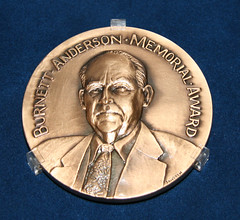 Along the way we've won multiple awards including the Burnett Anderson Memorial Award for Excellence in Numismatic Writing, back-to-back-to-back First Place awards in the electronic category of the American Numismatic Association's Barbara J. Gregory Outstanding Club Publications competition in 2021, 2022 and 2023, second place in 2024 and first place again in 2025.
Along the way we've won multiple awards including the Burnett Anderson Memorial Award for Excellence in Numismatic Writing, back-to-back-to-back First Place awards in the electronic category of the American Numismatic Association's Barbara J. Gregory Outstanding Club Publications competition in 2021, 2022 and 2023, second place in 2024 and first place again in 2025.
Despite the work that goes into each issue, it's always fun to put together. Our readers and fine advertisers are what keep me going - you folks are the best any editor could dream for, and we're not done growing and evolving.
Thanks again to all our readers, helpers, contributors and advertisers - we couldn't keep the train on the tracks all these years without your kindness and support. Onward!
For other reader comments, or to read our online archive, see:
http://e-sylum.org/
2025 NUMISMATIC LITERARY GUILD AWARDS
The Numismatic Literary Guild (NLG) is a separate organization from ours, the Numismatic Bibliomania Society (NBS). But we share a love of the numismatic hobby and numismatic research and writing in particular. Congratulations to all of the winners, many of whom are E-Sylum and NBS regulars. Here are this year's Awards Competition results. We've added images of some of the books which were announced or reviewed in earlier E-Sylum issues. See the links below for more information about adding these award-winners to your numismatic library.
Founded in 1968, the NLG is a nonprofit organization open to any editors, reporters, authors, writers, catalogers, webmasters, bloggers or producers of audio or video involving all forms of money, medals, tokens and other numismatic collectibles. Information about applying for NLG membership is available online at www.NLGonline.org/membership. -Garrett
David W. Lange Memorial Book of the Year - TIE
Korean Coins at the U.S. Mint & Korean Coins at the U.S. Mint
Mark Lovmo
David W. Lange Memorial Book of the Year - TIE
The Publications of Eric P. Newman: A Collector's Guide
Leonard D. Augsburger and Joel J. Orosz
Best Book: U.S. Coins
100 Greatest U.S. Coins, 6th Edition
Jeff Garrett
Best Book: World Coins
Korean Coins at the U.S. Mint
Mark Lovmo
Best Book: U.S. Paper Money
Paper Dreams in the Golden State: A History of California Through Its Paper Money
Dennis Hengeveld
Best Book: World Paper Money
Stock Certificates: Art and History
Peter Jones
Best Book: Tokens & Medals
World's Columbian Exposition Chicago
Steve Starlust
Best Book: Numismatic Investments
Junk Silver Bible: How to Safely Build Your Affordable Wealth Protection with Old Coins
Sebastian Wieschowski
Best Book: Numismatic History or Personalities
The Publications of Eric P. Newman: A Collector's Guide
Leonard D. Augsburger, Joel J. Orosz
Numismatic Columns or Articles: U.S. Coins to 1900
How the U.S. Dollar Began
Greg Reynolds
Numismatic Columns or Articles: U.S. Coins 1901 to Date
Liberty in Motion: Adolph Weinman's Iconic Masterpiece
Eric Brothers
Numismatic Columns or Articles: World Coins to 1500 (Includes Ancients)
The "Divas" of Ancient Rome, The Trojan War, Sports on Coins
NGCcoin.com - NGC eNews - NGC Ancients
Numismatic Columns or Articles: World Coins 1501 to Date
Early Coins and Currency of the Republic of Liberia
William Dalzell
Numismatic Columns or Articles: U.S. Paper Money
Building Canals with Paper
David Schenkman
Numismatic Columns or Articles: Tokens and Medals
Entertainment in 19th Century America Parts 1 & 2
David Schenkman
Numismatic Columns or Articles: Numismatic Spot News, Marketplace or Analysis
Potential Risks of Gold at $5,000 to $10,000
Maurice Rosen
Numismatic Columns or Articles: Numismatic Spot News, Marketplace or Analysis
2025 New World Order
Greg Reynolds
 Numismatic Columns or Articles: Numismatic History or Personalities
Numismatic Columns or Articles: Numismatic History or Personalities
John Harper, J.G. Hancock and the Washington Cents
Julia H. Casey
Best Numismatic New or Feature in a Non-Numismatic Publication
Numismatic Archetypes in the Year of Five Regents
Louis Inglis Hall
Ed Reiter Memorial Award for Best Column or Series - Numismatic Publications
Building a Set of Choice to Gem Quality Mercury Dimes, Part 3: 1930s
Greg Reynolds
James L. Miller Memorial Award - Article or Story of the Year
Eliminate? Is the Cent Next to Go?
Dr. Michael Fuljenz and Rick Snow
Periodicals: Best Investments Newsletter
Your Questions, My Answers
Maurice Rosen
Periodicals: Best Professional Periodical
2025 Book of Lists and How the U.S. Dollar Got Started
Scott Travers
Periodicals: Best Club or Not-for-Profit Periodical
American Journal of Numismatics
Nathan Elkins and David Yoon
Best Website/Digital: Best News or Blog Website
The Reading Room
Caleb Noel
Best Website/Digital: Best Dealer or Industry Website
Coins.HA.com
Paul Minshull, Michael Weems, Brian Shipman, Ryan Sokol & Jim Halperin
Best Website/Digital: Best Non-Trade Website
Coins, Community and Knowledge: The New Money.org
American Numismatic Association
Best Website/Digital: Best Numismatic Social Media Account
Stack's Bowers Instagram
Stack's Bowers Instagram
Auction Catalogs: Best U.S. Coins Auction Catalog
The Bruce S. Sherman Collection, Part II Platinum Session
Heritage Auctions
Auction Catalogs: Best World Coins Auction Catalog
The L.E. Bruun Collection: A Scandinavian Monetary History Part 1
Stack's Bowers Auctions
Auction Catalogs: Best Paper Money (U.S. or World) Auction Catalog
The Spring 2025 Showcase Auction, Including Selections from the Shores Collections, Part 1; The Eric Agnew Collection, Part II and the Haram Family Collection
Stack's Bowers Auctions
Auction Catalogs: Best Exonumia/Americana or Numismatic Literature Auction Catalog
Kolbe & Fanning's Sale 172 - Important Numismatic Books - January 25, 2025
Kolbe & Fanning Numismatic Booksellers
Video: David Lisot Memorial Video Award
Stack's Bowers Flowing Hair Gold Coins
Stack's Bowers Galleries
Numismatic Audio/Video: Best Podcast
Exploring a Coin Hoard, The King of Coins Greg Holloway, Civil War Dogs
Larry Jewett and Jeff Starck
Video: Best Software or App
HeritageLive!! www.HA.Com/Live
Heritage Auctions
Special Awards: Lee Martin Founder's Award - Best All-Around Portfolio
XF to AU Barber Half Dollars by Date
Greg Reynolds
Special Awards: The Ribbit
Pete Smith
Special Awards: The Clemy
Ron Guth
Extraordinary Merit - Audio/Video Podcast
The Coin Shop Podcast
Kenny Duncan Jr. and Matthew Duncan
Extraordinary Merit - Book: U.S. Coins
2026 Redbook of U.S. Coins
Whitman Publishing
Executive Director's Award of Excellence
For Dedicated Service to make rare coins and precious metals sales tax free.
David Crenshaw
To read the earlier E-Sylum articles, see:
NEW BOOK: 100 GREATEST U.S. COINS, 6TH ED.
(https://www.coinbooks.org/v27/esylum_v27n48a03.html)
NEW BOOK: KOREAN COINS AT THE U.S. MINT
(https://www.coinbooks.org/v27/esylum_v27n50a05.html)
NEW BOOK: PAPER DREAMS
(https://www.coinbooks.org/v27/esylum_v27n45a03.html)
NEW BOOK: STOCK CERTIFICATES
(https://www.coinbooks.org/v28/esylum_v28n11a06.html)
NEW BOOK: REFERENCING COLUMBIANA
(https://www.coinbooks.org/v28/esylum_v28n10a04.html)
NEW BOOK: PUBLICATIONS OF ERIC P. NEWMAN
(https://www.coinbooks.org/v28/esylum_v28n09a03.html)
2025 NLG BOOKS OF THE YEAR ANNOUNCED
(https://www.coinbooks.org/v28/esylum_v28n34a03.html)
NEW BOOK: THE BUDDHAPADA TYPE GOLD COINS
Deme Raja Reddy and M. Veerender's The Buddhapada Type Gold Coins is available. Here's information from the publisher's site. -Garrett
The Buddhapada Type Gold Coins
By: Deme Raja Reddy and M Veerender
 The origin of coins in India around the 6th and 7th centuries B.C. and the birth of Buddhism based on the teachings of Lord Buddha (563 B.C.-483 B.C) followed by its spread almost coincided. Unsurprisingly, Lord Buddha and Buddhism were represented in ancient Indian coins. The symbols that represented Buddhist faith were 1. tree in railing, 2. nandipada, 3. Chakra and 4. Eight-spoke wheel.
The origin of coins in India around the 6th and 7th centuries B.C. and the birth of Buddhism based on the teachings of Lord Buddha (563 B.C.-483 B.C) followed by its spread almost coincided. Unsurprisingly, Lord Buddha and Buddhism were represented in ancient Indian coins. The symbols that represented Buddhist faith were 1. tree in railing, 2. nandipada, 3. Chakra and 4. Eight-spoke wheel.
Another Buddhist symbol Buddha-pada which found its place in art and even in coins is a great revelation. The most significant observation was the finding of a hoard of 291 gold coins with the Buddhapada image from Mahbubnagar area. The design of gold coins with central image and images around the periphery is known from the coins of dynasties that ruled during the medieval period in Telangana. Though Buddhism flourished in Telangana in ancient times it disappeared with the revival of Hinduism from the time of Vish nukundins onwards in the region. The find of this hoard means that there were pockets of Buddhism in Telangana that flourished and issued such types of coins providing proof of the presence of Buddhism in this region for a longer period than known.
Format: Hardcover
ISBN-13: 9789391985608
Pages: 108p., All Colour Plates, 23cm.
Pub. Date: 22.07.2025, 1st ed.
Language: English
Price: US $103.50
For more information, or to order, see:
The Buddhapada Type Gold Coins
(https://www.bagchee.com/books/BB139325/the-buddhapada-type-gold-coins#)
NNP ADDS SAN FRANCISCO MINT NOTEBOOK
The latest addition to the Newman Numismatic Portal is a notebook compiled by San Francisco Mint Melter & Refiner Edwin R. Leach. Project Coordinator Len Augsburger provided the following report. -Editor
Newman Portal Adds San Francisco Mint Notebook
Recently discovered in a bookseller's stock by Wayne Homren, is a manuscript notebook of the San Francisco Mint Melter & Refiner, Edwin R. Leach. If the name sounds familiar, Leach was the son of the San Francisco Mint superintendent, Frank A. Leach, who saw the Mint through the 1906 earthquake and fire. The father, Frank A. Leach, later became the overall Mint Director.
The notebook, c. 1908-1909, discusses melting and refining processes and apparently represents a trip to the east coast, where Edwin Leach visited a number of smelting facilities. There are still great literature finds to be made "in the wild," as the discovery of this notebook clearly attests.
Image: Extract from the Leach Melter and Refiner's notebook
Link to Edwin R. Leach notebook:
https://archive.org/details/1909ustreasurydepartstock
Roger Burdette wrote, "A really great find by Wayne! Not unlike finding some of the Mickley diaries." I wouldn't go that far, but this is a really neat discovery. I brought it with me to the Oklahoma City ANA and lent it to Len for digitization. He took it with him this week to St. Louis, where it was scanned and added to the Portal.
Roger reviewed the scans and added this summary information. Thanks! -Editor
Background:
This is a manuscript notebook of the
San Francisco Mint Melter & Refiner, Edwin R. Leach.
The notebook, compiled during a 1909 trip to Denver and points east, discusses melting and
refining processes and apparently represents a trip to the east coast, where Edwin Leach visited a
number of smelting facilities. There are still great literature finds to be made "in the wild," as the
discovery of this notebook clearly attests.
Summary:
Melting and refining manuscript notebook, 1909, of Edwin Ralph Leach (1878-1971), while he
was Director of Melting and Refining at the San Francisco Mint. Leach was the son of Frank A.
Leach, Superintendent of the San Francisco Mint (1897-1907) and Director of the U.S. Mint
(1907-1909). Forty-two (42) pages of the notebook contain handwritten details about the process
of melting and refining metals at the various U.S. Mints and affiliated smelting companies,
including the San Francisco Mint, the Philadelphia Mint, Balbach Smelting & Refining
Company (Newark, N.J.), U.S. Metals Refining Company, et al. His handwritten notes provide
details on the melting and refining of various metals, including copper, silver, platinum,
palladium, and gold. Manuscript drawings are here and there among the text. Written on the front
page is: "PROPERTY OF / E. R. LEACH / U.S. MINT / SAN FRANCISCO."
The first 43 pages of this 6x9-inch volume describe gold, silver, and copper purification using electrolytic methods and custom built apparatus. Observations were made a several eastern refining companies and include drawings, equipment dimensions, electric current specifications and output per day or other period. On page 44, Leach describes the process used at the New York Assay Office, followed by the Philadelphia Mint's gold refining and recovery of platinum and palladium. He notes that in New York, some deposits contain as much as 200 parts per thousand of platinum, "which the depositor left knowing he would get nothing for it." Curiously, osmium and iridium are not discussed although they are common components of California gold (known as "iridosmine" or sometimes "osmiridium").
Leach's final pages are devoted to explaining how "old style" copper medals were antiqued, and then how modern (1909) medals were treated at Philadelphia. He closes with a brief description of "Nickel Working" and some sources for rubber gloves, ceramic chemical tanks, and other items.
Edwin Leach's eastward trip began on January 19, 1909 and he made several business stops, including Denver to New York via Chicago and Washington D.C. until reaching Philadelphia February 11. He was in New Orleans on March 9 and returned to San Francisco sometime around March 12. We have no details about when he visited private refiners in New Jersey and elsewhere, but it was likely in latter February. Throughout, there is neither a description of the Melting & Refining Department at San Francisco Mint, nor any mention of Edwin Leach's work there. However, his trip was intended to collect information and from that perspective, the notebook is a useful record of his observations.
VIDEO: GREAT NUMISMATISTS QDB MET
The David Lisot Video Library on the Newman Numismatic Portal can be found at:
https://nnp.wustl.edu/library/multimediadetail/522852
We highlight one of his videos each week in The E-Sylum. Here's one from 2009 with Dave Bowers speaking about the notable dealers and collectors he's met over the years. -Editor
 Among modern numismatists, few have reached the legendary status of Q. David Bowers. David has been a coin dealer researcher, auctioneer and award-winning author since the early 1950's. In this video and PowerPoint presentation he shares his personal stories about people like B. Max Mehl, the Norwebs, Abe Kosoff, John Ford, Harry Bass, and others. Speaker(s): Q. David Bowers.
Among modern numismatists, few have reached the legendary status of Q. David Bowers. David has been a coin dealer researcher, auctioneer and award-winning author since the early 1950's. In this video and PowerPoint presentation he shares his personal stories about people like B. Max Mehl, the Norwebs, Abe Kosoff, John Ford, Harry Bass, and others. Speaker(s): Q. David Bowers.
To watch the complete video, see:
Great Numismatists I've Met: From B. Max Mehl to Present Day
(https://youtu.be/WXIcLKP4AGw)
Great Numismatists I've Met: From B. Max Mehl to Present Day
(https://nnp.wustl.edu/library/book/560423)
ON AI IN NUMISMATIC PUBLISHING
Last week, Len Augsburger wrote that the "September issue of The Numismatist included this notice: 'A large percentage of the July 2025 cover story ('Coins of the Indian Subcontinent,' p. 26) was generated using artificial intelligence (AI) software, a fact the author did not disclose at the time of submission...' " -Editor
"I thought the Coins of the Indian Subcontinent article in the July issue of The Numismatist was far below the standards of what I expect from that publication. It was superficial, skipping over many important aspects and periods of Indian coinage. I was surprised it was the cover article. I assumed it had been written by a high school student.
My experience in using Microsoft Copilot AI for numismatic research is that about 20% of the time it comes up with incorrect information (e.g. incorrect metal content, reporting designs or denominations that do not exist, mixing up United States and Canadian coinage, etc.). It is a tool, but everything must be checked against reliable sources."
The notice also said that "Additionally, since late 2024, our review process includes the use of detection software to help identify AI-generated content." Justin Hinh submitted these thoughts. -Editor
As someone who has been closely following AI development over the past few years, I have to warn that AI detectors are inaccurate at best, fraudulent at worst. There are numerous stories about poor use of AI detectors by college campuses against students. Many of the so-called 'AI Checkers' like ZeroGPT, QuillBot, and others are just fancy frontends overlaid on ChatGPT with simple prompts such as, "Analyze the following text and give a percentage confidence on how much of the text was written by an AI." Of course, these AI detectors proceed to sell a service where they can 'Humanize' texts so that their systems can't detect that an AI wrote it.
ZeroGPT famously got in trouble in early 2023 when its AI claimed that an AI wrote the US Constitution.
This has led to countless false accusations against college students by uninformed professors.
I plugged in Len's response regarding The Numismatist kerfuffle, and it came back saying that only 48% of the text was written by a human.
I'm sorry to say, but AI detectors at this stage aren't reliable. These companies are offering inferior products and capitalizing on people's fears.
As a lifelong techno-optimist, I think today's generative artificial intelligence is a great tool that will only get better in time, but it is and will likely always remain just a tool that requires careful use. We all have to sharpen our critical thinking skills, not allow them to atrophy. -Editor
To read the earlier E-Sylum article, see:
NOTES FROM E-SYLUM READERS: AUGUST 24, 2025 : AI in Numismatic Publishing
(https://www.coinbooks.org/v28/esylum_v28n34a10.html)
NOTES FROM E-SYLUM READERS: AUGUST 31, 2025
Chateau de Ramezay Museum and Library Medals
Ted Banning writes:
"In case anyone wants to see more medals commemorating libraries, here are two that celebrate the opening of the Numismatic and Antiquarian Society of Montreal's library in 1896."
Perfect for The E-Sylum! Thanks. -Editor
To read the earlier E-Sylum article, see:
LIBRARIES ON COINS AND MEDALS
(https://www.coinbooks.org/v28/esylum_v28n34a13.html)
Dick Hanscom's NLG Pocket Piece Medal
Dick Hanscom writes:
"When we went to Korea in 1987 to pick up our adopted daughter I had this medal made. It has lived in my right pocket everyday since then, with the exception of international travel and when I lost it (and found it) twice. 38 years of pocket wear!"
Wow! That's a great pocket piece. Are other Numismatic Literary Guild medals out there? -Editor
To read the earlier E-Sylum article, see:
MORE ON AUTHORS ON COINS AND MEDALS
(https://www.coinbooks.org/v28/esylum_v28n33a12.html)
JEFF GARRETT: OKLAHOMA CITY GAMBLE PAYS OFF
Jeff Garrett published a nice post-ANA show article on the NGC website. Here's an excerpt - see the complete article online. -Editor
To everyone's surprise, board members of the American Numismatic Association (ANA) decided about four years ago to conduct the 2025 World's Fair of Money in Oklahoma City. The decision shocked many dealers who were accustomed to the organization choosing larger metropolitan areas. Post-COVID, the board was given fewer options, and there had been a serious case of Rosemont, Illinois fatigue.
Oklahoma City had recently constructed a new convention center and hotel complex, and the city's various amenities, including being home to APMEX (one of the largest rare coin dealerships in the world) seemed appealing. After much consideration, the board bravely chose to try something new.
There was immediate criticism from nearly every corner of the hobby. Dealers complained about the flight options, size of the city, remoteness of the location and a host of other issues. The contracts for the location had been signed, however, and the decision was final – the ANA was going to Oklahoma City in 2025. Members of the board have been nervous for the last few years awaiting the outcome of the event.
The first sign that the convention would be a success happened a couple of weeks ago when the bourse sold out. The ANA sold almost 500 tables to dealers from every corner of the United States and the rest of the world. A few dealers were left scrambling at the last minute trying to grab space at other dealers' tables to conduct business.
The ANA World's Fair of Money is also important for the many events, meetings and hosted dinners that occur over the course of the week. On Monday night, we attended an opening reception hosted by APMEX at the National Hotel. The hotel is a converted bank that was built in 1931 and has one of the most magnificent lobbies we have ever seen. The downstairs vault space has become an imaginative bar space, with traces of its glorious past, including circa 1931 safe deposit boxes.
The first indication that retail buyers made the trek in large numbers could be seen at the ribbon-cutting event Tuesday morning. The lobby was buzzing with excitement, and collectors filled the hall waiting to be let in. At the conclusion of the opening ceremony, the doors opened and collectors from around the world flooded into the hall. Dealers heard the loudspeaker announcing that it was time to man your tables.
From the start of retail business on Tuesday morning until we were removing coins from our cases on Saturday, people were buying coins in numbers seldom seen. Visitors had not only come to Oklahoma City to attend the show; they were there to buy coins. Every dealer I have talked to told me they had one of their best shows in years, if not ever. Interestingly, even dealers in the world and ancient sections reported similar results.
The decision to choose Oklahoma City for the 2025 ANA World's Fair of Money now seemed like a great idea. Contrary to the concerns of many, attendees seemed excited to see a new part of the country. Oklahoma City is a beautiful city, with spacious parks and several interesting downtown districts that have recently been renovated.
In the end, Oklahoma City may have been a risky choice for the ANA, but the event did not disappoint anyone in attendance. I heard more than a few dealers wondering when the ANA will choose to come back!
Having never been there, I was both wary and curious about Oklahoma City. I also suffer from Rosemont fatigue, although I do like the venue (and like Pittsburgh the best - but as a native I'm biased). Although fewer NBS members seemed to be there, our events were well attended, the bourse was always buzzing and nearly every dealer I spoke to said their show was outstanding. I was constantly busy running into and talking to people, and missed many of the presentations I'd optimistically added to my calendar. The brandy-new convention center and hotels were nice, with additional dining options a relatively short walk away. -Editor
To read the complete article, see:
Jeff Garrett: Gamble Pays Off for World's Fair of Money
(https://www.ngccoin.com/news/article/14417/)
THE BOOK BAZARRE
SEPTEMBER 2025 GREAT AMERICAN SHOW
The Great American Coin & Collectibles Show will hold its first show in the Chicago area from September 25-27, 2025. Artifacts from the S.S. Central America will be displayed. -Garrett
The Great American Coin & Collectibles Show comes to the Chicago area for the first time, Thursday to Saturday, September 25-27, 2025. The show will be in Hall F of the Donald E. Stephens Convention Center, 5555 N. River Rd., in the Chicago suburb of Rosemont, Illinois.
Numismatic artworks will be given away to the first 100 visitors each day.
The show is sponsored by Shepherd Expos Management and Amos Media, publisher of Coin World and Linn's Stamp News. There will be hundreds of dealers in the bourse; a featured display of California Gold Rush recovered sunken treasure artifacts; PCGS (www.PCGS.com) on-site grading and authentication; and auction lot viewing by Heritage Auctions (www.HA.com).
"This will be a golden event for visitors with a display of retrieved treasures and an important educational program about buying and selling gold," stated Larry Shepherd, president of Shepherd Expos Management.
Special attractions include artifacts from the fabled Ship of Gold, the S.S. Central America that sank in 1857, and an educational seminar about gold conducted by award-winning author and consumer advocate Scott A. Travers.

California Gold Rush-era artifacts and coins recovered from the fabled "Ship of Gold," the S.S. Central America, will be displayed at the Great American Coin & Collectibles Show in Rosemont, Illinois, September 25-27, 2025. (Photo courtesy of California Gold Marketing Group.)
 Bob Evans, the chief scientist on Central America recovery missions, will meet with visitors at the show.
Bob Evans, the chief scientist on Central America recovery missions, will meet with visitors at the show.
On Thursday and Friday mornings, September 26 and 27, Evans will be discussing the Ship of Gold with Greg Darnstaedt, an Illinois collector who is displaying recovered gold coins and miners' gold dust treasures from the legendary ship. The display will also include fascinating ship and passengers' Gold Rush-era artifacts that were retrieved from more than 7,000 feet under the Atlantic Ocean.
"The artifacts Greg has assembled tell much more of the S.S. Central America story than what can be understood by just looking at the wonderful gold coins and ingots. The value here goes beyond the mere monetary," said Evans.
"There are fascinating items of clothing and a hairbrush from surviving passengers, possessions that were lost to the dark depths for 133 years, even though their owners were saved. Now these things speak to how the passengers on the Ship of Gold lived. And there are pieces of equipment from the steamship, an oil lamp, a broken washbasin cracked during the sinking, and a piece of the rope the sailors used to climb up into the rigging," Evans explained.
Also, on Friday at 11 am, Anti-Counterfeiting Educational Foundation (www.ACEFonline.org) Executive Director Beth Deisher will present the organization's prestigious Alan Kreuzer Memorial Award to the 2025 recipient. The award recognizes the anti-counterfeiting efforts of collectors, dealers, law enforcement agents, or others who are diligently trying to protect the numismatic marketplace.
Visitors to the public ceremony can also watch the live recording of the popular The Coin Show podcast with hosts Matt Dinger and Mike Nottelmann.
 At noon on Friday, award-winning author, consumer advocate, and former American Numismatic Association Vice President Scott A. Travers will conduct a consumer/investor seminar, "Gold, Gold Bullion, and the State of the Coin Market."
At noon on Friday, award-winning author, consumer advocate, and former American Numismatic Association Vice President Scott A. Travers will conduct a consumer/investor seminar, "Gold, Gold Bullion, and the State of the Coin Market."
The first 100 attendees each day will receive a complimentary 8x10 fine art print of coins from the PentaMint Collection. A series of five original coin illustrations was created by numismatic artist Robert Julian specifically for this event. The prints on archival paper, to be randomly handed out, depict one of these rarities: the 1837-42 Bechtler $5 gold coin, the 1853-O Arrows and Rays half dollar, the 1854-D $3 Indian Princess, the 19-O $5 Indian, and the 1870-CC Double Eagle.

This image of a 1870-CC Double Eagle is one of the fine art prints from the Robert Julian PentaMint Collection that will be given to the first 100 attendees each day at the Great American Coin & Collectibles Show in Rosemont, Illinois, September 25-27, 2025. (Photo courtesy of Robert Julian.)
Heritage Auctions (www.HA.com), the Official Auction Company of the Great American Coin & Collectibles Show, will have lot viewing in the convention center before and during the show. In addition to Heritage, co-sponsors of the show include Legend Numismatics (www.LegendNumismatics.com), and Professional Coin Grading Service.
The Great American Coin & Collectibles Show will be open to the public on Thursday and Friday, September 25 and 26, 2025, from 10 am to 5:30 pm, and on Saturday, September 27, from 9 am to 3 pm. Admission is $10 for a three-day pass, and children 10 and under will be admitted free.
For additional Information and to pre-register online, visit www.GACC.show or contact event manager Larry Shepherd by phone at 719-464-8801 or by email at ShepherdExpos@gmail.com.
VOCABULARY TERM: RIPPLED SURFACE
Here's another entry from Dick Johnson's Encyclopedia of Coin and Medal Terminology. -Editor
Rippled Surface. Parallel rippled curves across the face on one side of a coin caused by grease left on a die or blank; or falling on either during coining; this heats up and imparts somewhat bubbly ridges during the heat of the coining impression. The problem of oil on the surface of either die or blank is the reason why both dies and blanks are treated before coining. Dies are cleaned with compressed air, blanks are metal cleaned. The effect was serious when knuckle-joint presses were used (either the Uhlhorn or Thonnolier presses) as oil spilled or dropped from the knuckle-joint above the bed where the striking took place. So serious was this problem in the 19th century that one firm, Greenwood and Batley, built a coin press with the knuckle-joint under the feed table to offset this problem!
To read the complete entry on the Newman Numismatic Portal, see:
Rippled Surface
(https://nnp.wustl.edu/library/dictionarydetail/516667)
COIN WORLD – A TALE OF TWO ISSUES
E-Sylum Feature Writer and American Numismatic Biographies author Pete Smith submitted this article on recent changes at Coin World. Thank you. -Editor
When I returned home from the ANA Convention, I laid out my back print issues of Coin World in order. There is a gap between the issues of August 12, 2024, and April 21, 2025, when I did not receive the paper. While the weekly edition of Coin World was interrupted, the monthly edition was intermittent. I have the August 2024 and December 2024 issues followed by February, March and April and continuing. The last issue of Coin World Trends was the June 2024 issue and has not been continued.
The E-Sylum previously reported on this including a December 1, 2024, statement from Coin World.
"Earlier this year, a business dispute arose between Amos Media, Coin World's parent company, and our contracted printing partner responsible for producing our coin and stamp publications. Despite repeated efforts to resolve the matter swiftly, the situation persisted for several months."
 I looked for a listing of Coin World staff in the August 12, 2024, issue. I found Editorial Director,
Larry Jewett / Editor-at-Large, Steve Roach and William T. Gibbs / Senior Editors, Paul Gilkes
and Jeff Starck. By the April 21, 2025 issue, only Larry Jewett and Paul Gilkes remained.
I looked for a listing of Coin World staff in the August 12, 2024, issue. I found Editorial Director,
Larry Jewett / Editor-at-Large, Steve Roach and William T. Gibbs / Senior Editors, Paul Gilkes
and Jeff Starck. By the April 21, 2025 issue, only Larry Jewett and Paul Gilkes remained.
Coin World has many contributors. In four issues before the break, they included David T, Alexander, Chris Bulfinch, Thomas Cohn, Mike Diamond, Michael Fahey, Ross Johnson, Brad Karoleff, Bill O'Rourke, Joel J. Orosz, John Roberts, Gerald Tebben, Wendel Wolka, and Vicken Yegparian.
For the first four issues after the break, they included David T. Alexander, Chris Bullfinch, Thomas Cohn, Mike Diamond, Kevin Harper, Ross Johnson, Bill O'Rourke, Joel J. Orosz, John Roberts, and Vicken Yegparian. Thus most of the contributors had stayed on.
Gerald Tebben's last "Coin Lore" column was in the March 2025 issue. Joel J. Orosz. "The Numismatic Bookie," announced his retirement effective August 18, 2025. The "Collectors' Clearinghouse" articles by Mike Diamond were reprinted from earlier articles.
In May of 2024, the size of each issue was reduced from 42 to 34 pages. The May 27, 2024, issue listed seventeen advertisers. The May 26, 2025 issue listed eleven advertisers. The June 2, 2025, issue listed just five advertisers. That number fluctuates greatly from issue to issue. The three big auction companies continue to advertise. Individual coin dealer ads are far fewer.
My subscription to Coin World would have expired during the break. I was informed that my subscription would be extended. I will be giving serious thought to the value provided when time comes to renew. I suspect that subscription rates are declining.
Coin World did not have a booth at the ANA World's Fair of Money in Oklahoma City. That is unusual. It is apparent that Coin World is going through hard times. Can they recover?
Coin World was discussed at the meeting of the Rittenhouse Society. There is concern that there is currently little opportunity for commercial writers. Many of us grew up with Coin World as our source for current news of the hobby. Perhaps with all the opportunities for free digital media, there is no longer a viable market for a weekly coin paper.
I believe that current numismatic historians should report on what is currently happening to create a record for future research.
Thanks, Pete. We'll look forward to chronicling future developments and wish Coin World the best in moving toward the future. The hobby itself is booming, and coin publications continue to appear in various formats, as seen in this year's NLG awards elsewhere in this issue.
As noted in my comments in the previous article, The E-Sylum is a different animal from the traditional numismatic publications like Coin World and Numismatic News - from the beginning we've avoided discussions of grading, pricing, and the latest U.S. Mint products, preferring instead to focus on books and research, and the history of numismatics and the numismatic hobby. We have no reporters or fact checkers, and are partly a blog and a moderated community. Our learned and active readers are often the ones who relay news, add additional facts and nuance, and correct mistakes. But the numismatic world still needs real reporters to dig into the important issues of the day, and that can be done with or without a print edition. And the numismatic community needs to support these reporters and their efforts. I heard that Coin World advertising manager Brenda Wyen was at the show, and I hope dealers kept her busy booking ads for upcoming issues.
Yes, dealers and auction houses now publish on the open internet, making information freely available. But given that deluge it's more important than ever for reporters and commentators to make sense of the information and provide perspective. But even that isn't enough - investigative reporting is sorely needed to dig behind the headlines and discover the stories we need and want to know. That's the essence of reporting. A bot can republish a press release, but only a real newshound can suss out the parts unsaid that matter most to the rest of us.
As for me, I recently re-upped my online Coin World subscription and received fast service for a question to their help desk about a password reset issue. -Editor
To read the earlier E-Sylum articles, see:
COIN WORLD PRINT EDITION STATUS
(https://www.coinbooks.org/v27/esylum_v27n48a13.html)
JEFF STARCK MAKES A MOVE
(https://www.coinbooks.org/v28/esylum_v28n02a15.html)
NOTES FROM E-SYLUM READERS: AUGUST 17, 2025
(https://www.coinbooks.org/v28/esylum_v28n33a14.html)
HUNTER HICKS PROFILED IN UVA TODAY
Young Numismatist Hunter Hicks was recently profiled in the University of Virginia's UVA Today about his burgeoning coin business. -Garrett
When Hunter Hicks first took a serious interest in collecting rare coins, his parents grew concerned. Their son's hobby didn't exactly match that of other preteen boys.
"Oh," they'd ask him, "you'd rather go hang out at a convention center with old people rather than, like, play soccer?"
As he did when he was 10, Hicks, now 21, is happy to respond to all inquiries regarding his unique passion. The University of Virginia fourth-year student runs a lucrative rare coin collecting business – Hicks Coins generated more than $960,000 in revenue in 2024 alone – in addition to studying at UVA's Frank Batten School of Leadership and Public Policy.
"Sometimes I look at the history of a coin," Hicks said, "and I'm like,'Oh my gosh, this is a silver dollar from 1857.' I don't know how to describe the appeal to me, but it's just so cool to have this item of value that so many hands have touched and appreciated along the way."
Curiosity turned into a hobby. Then it became a business.
The Falls Church City native learned more about the industry through local clubs in Alexandria and Fairfax, as well as summer excursions to Colorado and California for coin seminars. In high school, Hicks began working for coin wholesalers and coin shops. He established Hicks Coins in February of his senior year in high school.
"I realized I could have this business model with a very lean operation, without a big office and without someone working there 40 hours a week in person," said Hicks, who operates out of a low-rent office space and doesn't have full-time assistants. "I've built a fairly robust system of wholesaling. I do a ton of business on eBay. I do a ton of business at shows. It's just kind of finding the right place to sell this stuff."
During the 2024-25 academic year, Hicks took business trips to Chicago; Orlando, Florida; San Francisco; Baltimore; Charleston, South Carolina; and Syracuse, New York, as well as having dozens of local adventures.
Hicks recently found clarity at a Starbucks while traveling home from making an out-of-state deal. It was late at night, and he had a class in the morning.
"I just got this dopamine rush, and I was like, 'I just can't imagine another industry where I'm going to have this much fun and be this excited to be driving back from the Eastern Shore of Maryland at 11 p.m.,'" he said
"It was this feeling of, 'This is what I should be doing for the rest of my life.'"
To read the complete article, see:
Meet the UVA student building a rare coin empire
(https://news.virginia.edu/content/meet-uva-student-building-rare-coin-empire)
ON THE PROVENANCE OF THE 16TH 1804 DOLLAR
Douglas Ward submitted this article with his thoughts on the earlier provenance of the newly-discovered James A. Stack Class III 1804 Silver Dollar. Thank you! -Editor
1804 Class III Bust Dollar initially owned by Mint Director H. R. Linderman. Struck for him by Mint Chief Engraver A. L. Snowden. When seized by the government in 1887 his widow claimed it had been bought from a coin dealer. (The Smithsonian National Numismatic Collection, NMAH-2005-27312.)
Condition, Preservation and Origin
The condition and high level of preservation indicate 1804 Dollar-No. 16 passed through very few hands. Instead and to this day, it occupied the dark corners of the netherworldly Numismatic Cabinet. This assertion implies it was not sold into the collector market of the mid-to-late 1870's, along with most of its Class III sisters. Instead, it was likely held close to its original purveyor. That would have been the Mint's Chief Coiner at the time, Col. Archibald Louden Snowden. From his position, the rogue Colonel produced all the Class III 1804 dollars and sold them through the Chapman Brothers and Capt. John W. Haseltine, the numismatic fences of the time. Nothing passed through the Mint's press room without his privy approval. Between 1867 and 1885, this is evidenced by his striking of the vast majority of pattern coins ever produced at the Philadelphia Mint, more than 1,100 and in numbers exceeding 20,000 pieces.
LEFT: 1876 picture of Colonel Archibald Loudon Snowden, Chief Coiner of the Philadelphia Mint and nephew of James Ross Snowden. (Courtesy of the Philadelphia Free Library Print and Picture Collection.)
RIGHT: Henry R. Linderman, 12th & 14th Director of the Mint, 1867 – 1869 & 1873 – 1878. (Courtesy of the Library of Congress.)
His boss and Director of the Mints, Henry R. Linderman, was complicit and retained an 1804 dollar, which was sold at auction with his collection in 1888. Linderman passed away in office in 1879 and Snowden twice refused his position in favor of Superintendent of the Philadelphia Mint, where he could continue his pattern enterprise. Linderman's collection was first brought to auction by Lyman Lowe in 1887, but was seized by Treasury agents. After rifling through and retaining several lots, the balance of the collection, including his 1804 dollar, was returned to his heirs and sold at auction to James Ten Eyck and is now in the Smithsonian. With extreme likelihood, Col. Snowden surely retained an 1804 dollar in his collection of mementoes. It would have been the best example and grouped together with the likes of the twin 1877 gold Half Unions, gold 1876 Double Eagle patterns and a number of 1885 silver Trade Dollars, among its many delicacies. The gold Half Unions were later used as trade bait in the Great Pattern Plot of 1910. Both were bought from Snowden for $10,000 each, an enormous sum and record that persisted for decades. They were then traded to Mint Director A. Piatt Andrew in exchanged for all the pattern coins remaining in the basement of the Philadelphia Mint, some 9,000 pieces – comprising The Most Singular Lot. An 1804 Dollar was strangely absent from this vast menagerie. To not contain an 1804 dollar would have been an afront to the preeminent, but furtive, Chief Coiner, who passed away in 1912.
Patterns and fantasy coins from the amongst the mementoes of Chief Coiner A. L. Snowden: 1877 gold Half-Union, 1885 Trade Dollar and 1876 gold Double Eagle. (Courtesy of the Smithsonian, USPatterns.com and NGC.com.)
Provenance Scribe
So, who would have received No. 16 from Col. Snowden? Was it William H. Woodin, who bought the gold Half Unions and later traded them for the Mint's pattern treasure trove? That's possible, but Woodin did not engineer the plot that brought him a fortune in patterns and numismatic fame. That stroke of genius fell to Edgar H. Adams, a fellow member of the New York Numismatic Club. Messier Adams was used to working in the shadows and amongst the New York Numismatic illuminati. At the time, they were the center of the Numismatic Universe.
Without the personal means, Mr. Adams would use his numismatic knowledge and prolific pen to position himself. It was as a writer for The Numismatist, and more importantly The Sun newspaper of New York, that he gained prominence. His cloak and dagger, nom de plume nature was revealed when writing as L'Alouette, the lark of the 1909 ANA convention. His chirping in Mehl's Numismatic Monthly contributed to the infighting and coup attempt that almost toppled the ANA's evolving organization. It was during this time that he began laying the ground work for the Great Pattern Plot with articles in The Sun that trumpeted the sale of the gold Half Unions. Up to that moment, notice of pattern exploits were reserved to ANA convention 'smokers' and whispering, and the back pages of auction catalogs.
Edgar H. Adams as Assistant Editor of The Numismatist, c. 1909, and competing in the 1904 Olympic Games in St. Louis, MO. Probable owner of 1804 Dollar No. 16. (Courtesy of ANA and Missouri Historical Society.)
Pattern Plot Twist
Despite his wealth and political connections, Mr. Woodin could not have pulled off the greatest numismatic trade, or dare I say heist, that has ever or will ever be perpetrated. He would need the inspiration and help of his NYNC friends, some of whom did have Mint connections through the Assay Commission and other officials. These strings were pulled by the likes of NYNC member Thomas L. Elder. Others were pulled by Farran Zerbe and Capt. Haseltine – useful tools – who acted according to their true numismatic nature, if not on their own volition. But the master plot was laid out by Edgar H. Adams and as part of his reward, I would postulate – he was bestowed with 1804 Dollar-No. 16, which came directly from Col. Snowden.
At age twelve, young Esquire Adams was accidentally maimed after stepping on a shotgun, which left one leg shorter than the other. Hence, he walked with a cane, but was able to otherwise cloak his infirmity. For physical activity, he took up swimming and became rather good. He won the quarter-mile Brooklyn championship of 1902 and competed in the 1904 Olympic Games in St. Louis. The games were held at the same time as the ANA Convention and Louisiana Purchase Exposition. To keep a sharp mind, he dove headlong into numismatics and started writing. In 1904, he began contributing to The Sun newspaper by penning a coin related column and articles for which he was paid $12 each.
New York Numismatic Club meeting minutes from May 14th, 1909, (left) the same day the sales contract for the 1877 gold Half Unions was signed. The contract between Capt. J. W. Haseltine (right) and W. H. Woodin was written and witnessed by E. H. Adams. (Courtesy of the ANA and PCGS.)
Beyond the NYNC, he was a member of the ANA and ANS, but never sought an office or much prominence. In his study of U. S. pattern coins, he undoubtedly contacted Col. Snowden, formed a relationship and learned much of his clandestine endeavors. That affiliation spawned the Great Pattern Plot and contributed heavily to the accounting in his 1912 catalog of U. S. Pattern, Trial and Experimental Pieces. He may have introduced Col. Snowden to Mr. Woodin as part of his plot and promoted the sale of the Half Unions. He then wrote and witnessed the contract for their sale, executed between Mr. Woodin and Capt. Haseltine! For his part, Haseltine would reprise his earlier 1870's role in fencing 1804 dollars, which further validates his relationship with Col. Snowden. Mr. Woodin was chosen for his deep political connections, deep collecting interest and deep pockets.
No. 16 was probably the price Edgar H. Adams held for holding his tongue about the exploits of the entire pattern cabal – a fantastic story he would take to his grave. Mr. Adams could have, would have, and did keep secrets and likely sold No. 16 to Mr. Stack before his death in May of 1940. He would have chosen Mr. Stack for his familiar persona, collecting acumen and New York affiliation.
Sources
"The Fantastic 1804 Dollar," by Eric P. Newman and Kenneth R. Bressett, Whitman Publishing Co., Racine, Wisconsin, 1962.
"The ANA Election of 1909 as Viewed Through Its Membership Applications from 1907 to 1910," by Douglas Ward, The Asylum, vol. 40, no. 1, 2022.
"The Mystery of L'Alouette: The Lark of the 1909 ANA Convention," by Douglas Ward, The Asylum, vol. 40, no. 4, 2022.
"Surreptitious Pattern Recognition," by Douglas Ward, unpublished, 2023.
"Of Patterns, Plots and the Most Singular Lot," by Douglas Ward, ANS Magazine, no. 2, 2025.
"The Paradigm in Aluminum Patterns," by Douglas Ward, Pacific Coast Numismatic Society, Online publications, 2025.
To read the earlier E-Sylum articles, see:
STACKS BOWERS: UNPUBLISHED 1804 DOLLAR
(https://www.coinbooks.org/v28/esylum_v28n33a09.html)
ANA CONVENTION COMMOTION AND 1804 DOLLARS
(https://www.coinbooks.org/v28/esylum_v28n34a06.html)
MORE ON THE JAMES STACK JR. 1804 DOLLAR
(https://www.coinbooks.org/v28/esylum_v28n33a10.html)
ATLAS NUMISMATICS SELECTIONS: AUGUST 31, 2025
Atlas Numismatics has updated their website with 209 new coins, medals, and tokens at fixed prices. Select items are discussed below. -Garrett
1083464 | GREEK. CORINTHIA. Corinth. Struck 4th Century BC. AR Stater. NGC MS (Mint State) Strike 5/5 Surface 5/5. 19.5mm. 8.65gm. Pegasus flying left, koppa below /Head of Athena to left, wearing Corinthian helmet; rose behind her neck. Ravel 997; BMC 327; HGC.4, 1848. High relief lustrous surfaces; an exceptional example.
Ex Astarte SA, Lugano Auction 1 (11 May 1998) Lot 96.
$9,850
To read the complete item description, see:
Superb Corinth Stater
(https://atlasnumismatics.com/1083464/)
1082900 | FRANCE. Napoleon III. (Emperor, 1842-1870). 1862 AV Medal of 50 Ducats Weight. PCGS SP63. By Albert Désiré Barre. Edge: OR (bee). 59.5mm. 170.12gm. NAPOLEON III - EMPEREUR. Laureate bust, right; signed below truncation / PUPILLES DE LA - MARINE// 15/ NOV/ 1862// LE CTE. P. DE CHASSELOUP-LAURAT/ MINISTRE DE LA MARINE ET/ DES COLONIES. Crowned allegorical figure of France seated at right and facing left with anchor and dated memorial while holding her mantle over four children to left; signed lower right, legend above and three-line inscription in exergue. Page-Divo 468; cf. Brettauer 3134 (Silver); cf. Essling 1750 (Bronze). Struck for the inauguration of the naval orphanage. Exceedingly rare and quite likely unique; the only gold example mentioned by Page-Divo.
Ex Auction Leu Auction 14 (1975) Lot 553. . Housed in an oversized holder. Images of the Page-Divo reference catalogue are reproduced here for illustration purposes only. They are not included with the item listed for sale.
$77,500
To read the complete item description, see:
Likely Unique Napoleon III Medal in Gold
(https://atlasnumismatics.com/1082900/)
1082844 | GERMAN NEW GUINEA. 1895-A AV 20 Mark. PCGS MS64. Berlin. Denomination and date in palm wreath / Bird of Paradise. KM 9; Jaeger 709; Fr.-1; D&S-385. From a reported mintage of just 1,500 pieces for both Proof and Business Strikes. Superb semi-prooflike surfaces.
$95,000
To read the complete item description, see:
Exceptional German New Guinea 20 Mark
(https://atlasnumismatics.com/1082844/)
1083124 | GERMAN STATES. Bremen. (1631-1660) ND AV Marriage Medal of 10 Ducats Weight. PCGS MS62. By J. Blum (Bremen). 43mm. 36.88gm. GOTT UNSER HERZ... Two hands from clouds with a burning heart, below a pair of pigeons, on top the radiant name of God / EIN GLÜCK-HENN...// AMORE ET SEDULITATE. Hen with chicks. cf. Jungk 391, #29. "Ein Glückhenn". Exceedingly rare in gold and the only example we have been able to locate.
$89,500
To read the complete item description, see:
Marriage Medal of 10 Ducats Weight
(https://atlasnumismatics.com/1083124/ )
1083328 | GREAT BRITAIN. Victoria. (Queen, 1837-1901). 1897 AV Medal of 28 Ducats Weight. NGC MS65. Edge: Plain. 55mm. 95.26gm. VICTORIA ANNVUM REGNI SEXAGESIMVM FELICITER CLAVDIT XX IVN. MDCCCXCVII. Crowned and veiled bust left / LONGITVDO DIERVM IN DEXTERAEIVS ET IN SINISTRA GLORIA 1837. Head left, wearing bandeau, atop bundle of olive branches. BHM 3506; Eimer 1817a. Diamond Jubilee.
Housed in an oversized holder. Includes original case.
$55,000
To read the complete item description, see:
Gem Diamond Jubilee Medal of Victoria
(https://atlasnumismatics.com/1083328/)
1083109 | NETHERLANDS. Zeeland. 1683-(Tower) AV 30 Gulden. NGC MS63. 20.91gm. LUCTOR ET EMERGO (mm). Standing knight with raised sword and provincial arms of Zeeland below at left / (date) * MO: NO: AUR: ORDIN: ZEELANDIAE *. Arms of the cities of Zeeland flanked by denomination 30• - •G. KM P16. Rare; CNM 2.49.122; Delmonte 893 (suppl.); Friedberg 309 ("Very rare"); Purmer/van der Wiel Ze 62.3; Vanhoudt/Saunders 1343 (R3).
Struck in gold to the weight of 6 Ducats . Currently the finest known at NGC as of June 2025
$125,000
To read the complete item description, see:
Mint State 30 Gulden of Zeeland
(https://atlasnumismatics.com/1083109/)
1083573 | POLAND. Danzig. 1644 AR Medal. NGC MS64. By S. Dadler. 60mm. Bellona the allegorical figure of War struggles with Pax, fighting for peace on earth. At left, a globe with Mercury's caduceus, palm and olive branches, offered to the combatants; to the right, the Gorgoneion (shield of Pallas Athena with the Gorgon's head) and a lance leaning against an olive tree / Allegorical figure of Pax (Peace) standing over the war god, Mars who is lays defeated upon the ground. In her right hand she holds Mercury's caduceus and three ears of grain, in her left hand a palm, laurel and olive branch. In the background, Themis standing with her sword and scales, while to the right Abundantia stands with cornucopia and olive branch. Between them a farmer ploughs a field before a cityscape. Pax in Nummis 83; Van Loon II, S. 315 (Histoire metallique II, S. 304); Deth./Ord. 1; Maué 54. On the beginning of the negotiations for the Peace of Westphalia.
$12,500
To read the complete item description, see:
Large Format Dadler Medal for Danzig
(https://atlasnumismatics.com/1083573/)
Updates to their online inventory are issued monthly.
For more information and to sign up for the firm's monthly newsletter, visit:
atlasnumismatics.com.
1935 GEORGE V SILVER JUBILEE CROWN IN GOLD
Steve Hill of Sovereign Rarities submitted this article about a rare piece being offered to the market for the first time in their upcoming September sale. Thanks! -Editor
Sovereign Rarities are proud to present for their 19th Auction to be held at their London office on Tuesday 23rd September an example of the George V Silver Jubilee Crown dated 1935 struck in gold.
This coin is one of the 25 pieces struck in gold that was supplied to the public by a ballot for the right to buy as it was so heavily oversubscribed with 1,329 applicants wanting to purchase an example at the £50 asking price in May 1935. While such coins do turn up for sale (Heritage sold one in late August 2025 for a total of $150,000) the really interesting thing with this one is that it has been family owned since it was obtained new in May 1935!
After 90 years the grandchildren of the original purchaser Mrs B Hindley have decided the time is right to sell. Their grandmother, one of only six women who succeeded in purchasing one of these coins, had always told her family never to handle the coin and it sat for nine decades in its original case.
The coin is accompanied by its original paperwork from the Royal Mint signed by Deputy Master and Comptroller Robert A Johnson. A congratulatory letter of 15th May 1935 and a list sent on 23rd May 1935 of all the successful applicants. The issue of the gold crown, its method of sale and distribution by ballot even reached the realm of Parliamentary debate on 27th May 1935 (series 5, volume 302) with all the names and addresses of the recipients listed and still available to see on Hansards Parliamentary Proceedings of the House of Commons ROYAL MINT (DISTRIBUTION OF GOLD PIECES). (Hansard, 27 May 1935)
One of the most interesting things to note today is that the issue price of £50 was a great deal of money in 1935 especially when compared to the then current retail values of significant collector coins as gleaned from the Spink Numismatic Circular. A Victoria Una and the Lion Five Pounds of 1839 appears for sale in the August 1935 edition for £20 and a slightly lesser grade one on the October edition at £16/10. Even the following year in March of 1936 an 1839 Five Pounds was still only £22, a coin that easily tops £200,000 at auction today when very well preserved.
The release of the 1935 gold Silver Jubilee crown to the public numbered just 25 pieces, which is one sixteenth of the approximated mintage of the Una and the Lion Five Pound piece at circa 400 pieces. This comparison speaks volumes as to perhaps how under appreciated by value this rarity truly is, it being almost now at the halfway point in date between the issue of the Una and lion of 1839 and today.
Just how many more of these 1935 gold crowns are still with the original owner families is impossible to fathom, but the cataloguer Steve Hill can honestly say it is only the second time in a 35 year coin career that he has encountered a gold crown from the original family ownership. The last time being in the late 1990s when he met a 99 year old original successful applicant and recipient of the coin – Norman B. Kark (died in 2000 age 101), something that is impossible to occur now.
The Hindley example of the 1935 Crown in gold for George V’s Silver Jubilee has since been certified by NGC as number 8464516-001 with a resulting straight grade of PF64 + Ultra Cameo and we expect it to sell in the region of £100,000+.
The online catalogue will appear at www.sovr.co.uk this coming week.
Steve kindly provided images of the accompanying documentation. See our Flickr album for larger images. -Editor
To see the paperwork accompanying this George V Silver Jubilee Crown dated 1935 struck in gold, see:
Hindley 1935 George V Silver Jubilee Crown in gold
(https://www.flickr.com/photos/coinbooks/albums/72177720328713335/)
The other major consignment for the 23rd September auction is the Thorburn Collection of coins and medallions of 1887 mostly issued to celebrate the Golden Jubilee of Queen Victoria and numbering to over 200 pieces in 198 lots. The collection has all 1887 dated denominations whether young, gothic or Jubilee style head of nearly all formats and die variations.
This is the most significant collection of coins of one date to come to public auction in this generation and perhaps ever as it also contains many patterns and proofs with some unique. More will be revealed in the succeeding E-Sylums, but for now three of the most significant and valuable gold coins are the 1887 Pattern Five and Two Pound gold coins without the B.P. designer initials in the exergue on the reverse (NGC PF62 Cameo at £30,000-40,000 and NGC PF61 Ultra Cameo at £15,000-£20,000 respectively) and the 1887 Proof Young Head Sovereign with shield back reverse from London (NGC PF64 Cameo at £25,000-£35,000).
The "no B.P." Five and Two Pound pieces were pre-production trials of those denominations in early 1887 before the official proof and currency pieces appeared for sale and circulation after the Golden Jubilee date in June 1887. Both are each thought to number to less than 20 pieces in existence and remain the most highly prized of the Jubilee Five and Two Sovereign pieces.
The young head Proof Sovereign is even more of an extreme rarity with almost certainly less than five produced and hardly ever encountered for sale. This shield reverse and its St George reverse counterpart were thought to have been ordered in a very small number of proof assemblages of the young head coins of 1887 for a special VIP order perhaps by one of the branch mints for exhibition.
KUENKER AUCTION SALE 427
From 7 to 9 October 2025, the first part of Künker's Fall Auction Sales will be held. In addition to world coins and medals, the auctions feature several special collections on topics including Malta, the Ottoman Empire / Turkey and – presented in a separate catalog – the Henk Verschoor Collection with coins from the Dutch overseas territories. -Garrett
Are you interested in Islamic coins? Then you should mark 7 October 2025 in your calendar. Auction 427 will feature a small but impressive collection of Ottoman and Turkish gold coins. Connoisseurs can look forward to 66 lots, covering the period from Selim I (sultan from 1512 to 1520) to the Turkish Republic in 1975. Moreover, the attractive ensemble includes a variety of historically interesting specimens, as well as great rarities and luxury pieces.


No. 300: Ottoman Empire. Abdul Mejid, 1839-1861. 500 piaster, 1855 (= 1272 AH), Constantinople. Very fine to extremely fine. Estimate: 3,000 euros
This special collection forms part of the general catalog presenting gold coins and medals from around the world. Künker's once again presents an extensive range of interesting lots, including several extremely rare pieces, some of which in excellent condition and / or of utmost historical and numismatic importance.
These include, for example, a 2.5 ducat of Gotthard Kettler. He became famous as the last Landmeister (Master) of the Teutonic Order in Livonia because he placed himself under the protection of Poland, converted to Protestantism and founded his own duchy using part of the former Order territory, having been forced to do so by a Russian war of aggression. The coin, which was probably created in Riga, still bears his old title Magister Livoniae, used by the Masters of the Teutonic Order in Livonia.
Are you enthusiastic about Gothic gold coins from the late Middle Ages? If so, auction 427 offers a fine selection of issues from Flanders, Aquitaine, France and England. Of particular note is a London sovereign of Elizabeth I, which was of course struck in early modern times while its style with the horror vacui roots in the late Middle Ages.
Two extremely rare ducats from the Austrian princes of Lobkowitz und Sprinzenstein are also particularly noteworthy. The wealth of such princes is illustrated by the fact that, in 1676, Lobkowitz donated 190,000(sic!) guldens to the imperial war chest to finance the war against France. Count Johann Ehrenreich von Sprinzenstein was also an expert in financial matters, and particularly in coinage. He served as Obersterblandmünzmeister (chief mint master) in Upper and Lower Austria. By the way, you can still admire the dies of the 1717 ducat in the Castle Museum Linz, where they have been on permanent loan since 1979.


No. 2: Livonian Order. Gotthard Kettler, 1559-1561. 2 1/2 ducats, n.d., probably Riga mint. Extremely rare. About extremely fine. Estimate: 50,000 euros


No. 95: France / Aquitania. Edward, the Black Prince, 1362-1372. Hardi d'or, n.d., La Rochelle. Very rare. Extremely fine to FDC. Estimate: 17,500 euros


No. 117: England. Elizabeth I, 1558-1603. Sovereign n.d. (1584-1586), London. Very rare. About extremely fine. Estimate: 15,000 euros


No. 200: Russia. Peter II, 1727-1730. 2 roubles, 1727, Moscow, Red Mint. Very rare. Very fine. Estimate: 70,000 euros


No. 511: Austrian Princes. Ferdinand August von Lobkowitz. Ducat n.d. Very rare. Extremely fine. Estimate: 17,500 euros


No. 512: Austrian Princes. County of Sprinzenstein. Johann Ehrenreich, 1705-1729. 1717 ducat, Augsburg. Very rare. Extremely fine to FDC. Estimate: 17,500 euros
Of course, collectors of pieces from the German States will find an abundance of spectacular gold coins in auction 427. The offer includes, for instance, the quadruple ducat that the Bavarian estates presented to Elector Ferdinand Maria on the occasion of the birth of his son Ludwig Amadeus Victor on 6 April 1665. You will hardly find the name of the little prince in a work on Bavarian history, as he died just a few months later. This was not unusual in the 17th century. Henriette Adelaide, the wife of Elector Ferdinand Maria, lost four of her eight children while they were still toddlers.
A highlight of Brandenburg Prussian coinage is the 10-ducat portugaleser created on behalf of Joachim II in Berlin in 1570 to imitate the heavy Portuguese gold coins. Pay attention to the title that can be read on the obverse. It refers to Joachim II to as "Dux Prussie", i.e. Duke of Prussia. In fact, the Franconian line of the House of Hohenzollern held this title. However, Joachim enforced hereditary co-enfeoffment, which had a lasting impact on Prussian history.
Another noteworthy specimen is a Brunswick 10-ducat piece from 1706 with the portrait and the coat of arms of Anton Ulrich of Brunswick-Wolfenbüttel. Right above the coat of arms, it shows the prince’s motto CONSTANTER (= constant).
The ducat issued by the city of Emden in 1694 is something very special. After all, the reverse mentions its weight. The fact that the coin was minted with the weight of a Hungarian ducat seems surprising at first glance. After all, the country had only been under Habsburg control again since 1687, and the Ottomans had not even yet recognized this. However, the Kremnica mint was under Habsburg control. There, they minted ducats that – since Kremnica was not part of the Empire – were permitted to deviate from the imperial coinage regulation. Kremnica ducats were slightly less pure. Emden, however, was located on imperial territory. So if Emden wanted to mint a ducat with lower fineness, this had to be clearly indicated.
A 12-fold ducat of the reformist bishop Wilhelm Anton von der Asseburg, created on the occasion of his election as bishop of Paderborn on 25 January 1763, is estimated at 125,000 euros. This extremely rare coin, which is probably the only specimen in private hands and was once owned by the House of Metternich, was minted with the dies of the konventionstaler.


No. 531: Bavaria. Ferdinand Maria, 1651-1679. 4 ducats, 1665, Munich. PCGS MS63. Very rare. Extremely fine +. Estimate: 50,000 euros


No. 578: Brandenburg-Prussia. Joachim II, 1535-1571. Portugaleser of 10 ducats, 1570, Berlin. Extremely rare. Traces of mounting. Very fine. Estimate: 175,000 euros


No. 633: Emden / City. 1694 ducat. Extremely rare, probably unique. Extremely fine to FDC. Estimate: 20,000 euros


No. 643: Hamburg / City. Bankportugaleser of 10 ducats, 1689, by J. Reteke, commemorating the major European banking cities of Amsterdam, Hamburg, Nuremberg and Venice. Very rare. MS 63 PL. Extremely fine to FDC. Estimate: 50,000 euros


No. 729: Paderborn / Bishopric. Wilhelm Anton von der Asseburg, 1763-1782. 12 ducats, 1763, Neuhaus, commemorating his election as bishop. Minted with the dies of the konventionstaler. From the estate of the House of Metternich. NGC MS61. Extremely rare, probably the only specimen in private possession. Extremely fine to FDC. Estimate: 125,000 euros
The term "numisnautics" has established itself over the past few decades. It was coined by the German numismatist Wolf Müller-Reichau when he and a few colleagues launched the magazine Flaschenpost (message in a bottle) as an information bulletin for the Numismatics Working Group in Germany. While ship depictions have long been a popular theme for collectors internationally, Flaschenpost drew the attention of many German collectors to questions about the history of nautical science that can be answered with the help of coins. Künker is pleased to offer the collection of a Berlin numisnautist, the first part of which is divided between auction catalogs 427 and 428. A second part will be auctioned in an upcoming eLive auction.


No. 115: England. Henry VI, 1422-1461. Noble, n.d. (1422-1427), London. About extremely fine. Estimate: 1,500 euros
To order a catalog contact Künker, Nobbenburger Straße 4a, 49076 Osnabrück; phone: +49 541 / 962020; fax: +49 541 / 9620222; or via e-mail: service@kuenker.de. You can access the auction catalogs online at www.kuenker.de. If you want to submit your bid from your computer at home, please remember to register for this service in good time.
EGYPTIAN QUEEN BERENICE COIN FOUND
Archaeologists have discovered a coin depicting Queen Berenice, wife of Egyptian King Ptolemy III, in Jerusalem. It is the first Queen Berenice coin found outside Egypt, and it is surmised that the coin was used to reward veterans of the Third Syrian War. Thanks to Laurence Edwards for passing this along. -Garrett
For the first time, a gold coin featuring the Ptolemaic queen Berenice II of Egypt has been found in situ, more or less.
Technically, it was discovered while sifting archaeological material dug up from the "City of David" excavation under the former Givati parking lot in Jerusalem, of all places, the Israel Antiquities Authority revealed on Wednesday. So it hadn't been found exactly where it was dropped or lost, but its provenance is not in question.
According to the professional literature going back about a century, to date, about 20 coins showing Berenice, the wife of King Ptolemy III of Egypt, have been found, all in Egypt, says Robert Kool, head of the Numismatics Department at the IAA.
None of the Berenice coins had been reported beyond the Nilotic kingdom until today, and none of the rest had been found in their correct archaeological context insofar as is known, say Kool and Dr. Haim Gitler, chief curator of archaeology and numismatics curator at the Israel Museum.
It was identified as a quarter-drachma. One side shows Berenice as a queen, with the requisite tiara and veil, and wearing a necklace. The reverse shows a cornucopia flanked by two stars with the Greek inscription "of Queen Berenice." It had been minted in about 240 B.C.E. during the reign of Berenice's husband, her cousin Ptolemy III Euergetes (246–222 B.C.E.).
The monthly pay of a soldier was something like 2.5 silver drachmas, Kool says, and each drachma weighed 3.5 grams of silver. The Berenice coin, a mere "quarter drachma" would have been worth less than a soldier's monthly pay. He and the team surmise that the coin may have served as a reward to soldiers returning from the Third Syrian War, which pitted the two dominant Hellenistic powers at the time against each other: the Ptolemaic Kingdom of Egypt and the Seleucid Kingdom of Syria.
To read the complete article, see:
Ancient Coin of Egypt's Queen Berenice Found in Jerusalem Excavations for the First Time
(https://www.haaretz.com/archaeology/2025-08-22/ty-article/ancient-coin-of-egypts-queen-berenice-found-in-jerusalem-excavations-for-the-first-time/00000198-cd08-d1d0-af9d-dfa9074e0000?)
WHITHER SQUISHED PENNIES?
Len Augsburger passed along this article about the fate of pressed pennies (elongated cents to us numismatists). Thanks. Here's an excerpt - see the complete article online. -Editor
Carissa Gooding, a pressed-penny collector in Columbus, Ohio, who makes very satisfying- to-watch TikToks in which she cleans souvenir pennies with a Q-tip and metal polish while telling stories about where she pressed the coins, recently had a self-described "penny mental breakdown."
She found an old pressed penny from the Cincinnati Museum Center among her things, which led her to drive two hours to the museum, both to see a Barbie exhibit and to check out the machine—but it was nowhere to be found. An attendant told her they'd gotten rid of it last year, a result of the cost of maintenance compared to the money they actually make from the pennies, not to mention the imminent end of penny minting. "I was freaking out about this silly little penny press," she told me. "After that, I went home and was like, I have to collect every single penny."
In May, Donald Trump announced that in 2026,the U.S. Mint will cease production of the penny, one of which costs 3.69 cents to make. What will come of the good old-fashioned American vacation practice of pancaking our smallest monetary denomination? The machines have become a mainstay in tourist locations such as zoos, museums, theme parks, and historical attractions, and the coins usually feature designs of things you can see at the sites (the facades of buildings, zoo animals, roller coasters, spaceships, artworks— the options are endless). Though they've become more widespread and DIY in the past half century, pressed pennies have been around for more than 100 years. The first one is said to have been created for the World's Columbian Exposition, a fair in Chicago, in 1893. It's only now, in the twilight year of the penny, that machines for penny pressing—aka penny squishing, penny smashing, coin elongating—seem to be at risk. Voracious collectors are, perhaps counterintuitively, looking forward to it.
In addition to being some of the cheapest souvenirs, pressed pennies boast a community of exonumists, the technical name for these enthusiastic collectors. These hobbyists share photos and machine locations; they mail pressed pennies to other collectors around the country; they build penny chandeliers and set up elaborate displays for their hoards. And while many feel somewhat wistful about the end of the penny, they aren't too concerned that the practice will die out. In fact, it might even be made more special by the coin's impending rarity.
Gooding is not so worried about Trump's order having an effect, but she's still concerned that the machines will start falling out of favor with the destinations that host them. In the meantime, she plans to take advantage of the ones still in use and visit all the penny squishers in the state. Her most recent sojourn was to the Ohio State Reformatory, where much of The Shawshank Redemption was filmed.("I'm sorry," I asked, "even prisons have penny pressers?" Gooding confirmed.) Like many other pressing fanatics, she has experienced places she might not have visited otherwise, thanks to the draw of cranking out a new elongated coin.
"I'm not someone who necessarily seeks out a museum," she said, "so it forces me to go learn about the history of where I grew up—or birds or whatever."
I learned something new from the article - that coin mutilation is illegal in Canada, but the souvenir machines are there nevertheless, using copper blanks instead of coins. So I guess the people who supplied the U.S. Mint with blanks still have a (much smaller) market. Not that we'll ever be in danger of running out of real cents when billions are still out there in circulation and dresser drawers. -Editor
To read the complete article (subscription required), see:
Squished Dreams
(https://slate.com/life/2025/08/pennies-trump-pressed-collector.html)
US MINT ISSUES FIRST LASER-ENGRAVED COIN
Howard Berlin passed along this story about the Mint's new laser-engraved coin. I'd seen the press release and other articles about it, but didn't manage to get anything into earlier issues. Here's an excerpt - see the complete article online. -Editor
 As the American Numismatic Association concludes its annual convention – dubbed the "World's Fair of Money" – this weekend in Oklahoma City, the coin-collecting community continues to be plagued by one of its most pressing issues: A proliferation of Chinese-made counterfeits.
As the American Numismatic Association concludes its annual convention – dubbed the "World's Fair of Money" – this weekend in Oklahoma City, the coin-collecting community continues to be plagued by one of its most pressing issues: A proliferation of Chinese-made counterfeits.
According to the association, such fakes are more widespread than ever. They're often sold, experts say, through online auction facilitators such as eBay to unwitting collectors fooled by too-good-to-be-true bargains.
The U.S. Mint says its latest coin release, featuring laser engraving, marks a leap forward in counterfeit-busting technology, and some believe the agency may be thumbing its nose at bogus coin makers in the process.
"With the proliferation of Chinese counterfeits on online auction facilitators, the U.S. government is clearly stepping in and trying to do something," said Scott Travers, an author and numismatist who serves as editor-in-chief of COINage magazine. "The mint is trying to send a very public message by coming up with new technology that will thwart counterfeiters and set them back generations."
What makes this issuing unique is the first-time use of laser technology – in particular its laser-engraved privy mark, a design element typically used for marketing or historic purposes. For instance, a 2020 American Eagle coin commemorating the 75th anniversary of the end of World War II featured a privy mark reading "V75."
Experts say the fakes commonly appear on online auction sites, often offered at seemingly bargain prices. Supposedly one-ounce silver coins might be listed for as low as $16 despite the fact that the going price of silver is more than twice that.
"A lot of people fall into that trap," said prominent numismatist John Albanese, founder and CEO of Certified Acceptance Corporation, one of three major coin authentication companies serving the coin-collecting world. "But if the price of silver is $34 an ounce and someone is selling it for $16 or $19, you can guarantee that it's counterfeit. It's a minefield."
Albanese said counterfeits can look remarkably genuine, even to longtime collectors. He keeps a magnet in his office as one method of detecting silver fakes, usually made of steel – which unlike silver, will be drawn to the magnetic pull.
While the 2025 American Eagle represents a quantum leap forward, he said that still doesn't solve counterfeiting issues with coins produced in earlier years.
To read the complete article, see:
US Mint issues first laser-engraved coin. Some say it sends a message to counterfeiters
(https://www.usatoday.com/story/news/nation/2025/08/23/us-mints-first-laser-engraved-coin-marks-technological-milestone/85783290007/)
FALKLAND ISLANDS BANKNOTES TO SHOW KING CHARLES III
The Falkland Islands will issue new banknotes featuring King Charles III. Thanks to Dick Hanscom for passing this along. -Editor
[T]he Falkland Islands decided on a new set of banknotes and redesigns for the first time in over four decades. The redesign followed on a shortage of £5 notes which prompted a public consultation last year.
"Native plants and animals emerged as the public's favorite theme," said officials, who collaborated with banknote manufacturer De La Rue and a working group of local residents to bring the concept to life.
"This design celebrates our unique heritage and wildlife," noted the working group Falklands group.
The notes feature King Charles III and iconic wildlife including the King penguin, a reference of the Islands and the pale maiden the Falklands national flower.
In effect the £5 note showcases King Charles III on the front alongside black-browed albatrosses and a king penguin. The back features the national flower, the pale maiden, Steeple Jason Island, and depictions of five penguin species.
The same design will be used for the new £10 and £20 notes, while existing £50 notes will remain in use, with stocks projected to last for another 90 years.
The polymer notes will replace the old cotton ones and include security features such as the transparent king penguin window with iridescent ink, ultraviolet designs and infrared inks. It's anticipated the old notes will be withdrawn from circulation in 2026.
To read the complete article, see:
Falklands, invitation to celebrate launching of the new bank note collection
(https://en.mercopress.com/2025/08/03/falklands-invitation-to-celebrate-launching-of-the-new-bank-note-collection)
But wait - there's more! -Editor
The Falkland Islands Government Office (FIGO) in London will debut a short film showcasing the creation of the territory's new banknotes. The screening will take place on Wednesday, 13 August, at the Historic Dockyard Museum, coinciding with the official launch of the new currency series.
The film includes interviews with Hugo Burnand, His Majesty The King's Official Portrait Photographer—responsible for the image of the monarch featured on the notes—alongside MLA Leona Roberts and Falkland Islands Government Representative to the UK and Europe, Richard Hyslop.
Hyslop said the project offers "fascinating insights" into the creative process behind the King's portrait and the community's role in shaping the designs. "Working alongside the Treasury and manufacturers De La Rue, members of the Falklands community have helped shape the wonderful design of the new banknotes," he added.
To read the complete article, see:
Falkland Islands to premiere short film on new banknotes
(https://en.mercopress.com/2025/08/11/falkland-islands-to-premiere-short-film-on-new-banknotes)
SRI LANKA NOTE FOR THE VISUALLY IMPAIRED
A new banknote from Sri Lanka features raised bars to assist the visually impaired. -Editor
To mark its 75th anniversary, the Central Bank of Sri Lanka (CBSL) today, August 29, issued a Rs2,000 currency note with features for the visually impaired. This is the fifth commemorative currency note issued by CBSL.
 "To assist visually impaired people in identifying the note by touch, six raised bars, each with a diamond shape, are printed along both the left and right edges," the central bank said describing the new currency note.
"To assist visually impaired people in identifying the note by touch, six raised bars, each with a diamond shape, are printed along both the left and right edges," the central bank said describing the new currency note.
The front of the note features the CBSL head office, the Colombo lighthouse clock tower, a stylized Colombo skyline and the 75th anniversary logo. Meanwhile, the reverse side has a stylised map of Sri Lanka, a water lily, and the bank's vision statement.
The CBSL said that a colour-shifting security thread is embedded in the note to enhance security and facilitate public authentication.
To read the complete article, see:
Sri Lanka issues new banknote with features for visually impaired
(https://thepeninsulaqatar.com/article/29/08/2025/sri-lanka-issues-new-banknote-with-features-for-visually-impaired)
I reached out to Kavan Ratnatunga who writes:
"All Lankan notes since 2010 have had features for the visually impaired. My article will probably appear in the Sunday Times on Sunday, 7th Sept. No notes have been issued to the public as yet, and I only have images."
For more information, see Kavan's web page and CBSL YouTube video:
2025 - Sri Lanka
2000 Rupee note
(https://notes.lakdiva.org.lk/commemorative/2025_cbsl75_2000r.html)
Celebrating 75 years with a Commerative Currency Note
(https://www.youtube.com/watch?v=ruNZl9O8XMg)
LOOSE CHANGE: AUGUST 31, 2025
Here are some additional items in the media this week that may be of interest. -Editor
Scottish banknotes get no respect in England despite being legal tender. In the latest indignity, a pub chain has banned their use. -Editor
SCOTTISH banknotes have been banned by hundreds of JD Wetherspoon pubs across England, it has been revealed.
Bosses at the bar chain reportedly instructed staff not to accept any Scottish £20 and £50 notes from late November last year.
The decision comes after Wetherspoon bosses were warned by the Bank of England last October that a large number of fake Scottish £20 notes were being put into circulation by organised crime gangs, according to the Scottish Sun.
The news outlet reported that some Scots have been left "embarrassed" after their Scottish notes were refused at Wetherspoon's English branches over the last year.
A spokesperson for the pub chain has since apologised for the impact the policy is having on its customers.
Eddie Gershon told The Scottish Sun that the banning of Scottish £20 and £50 notes does not apply in Scotland, along with certain towns and cities with close ties to the city.
To read the complete article, see:
Wetherspoon bans Scottish banknotes across hundreds of pubs
(https://www.thenational.scot/news/25429475.wetherspoon-bans-scottish-banknotes-across-hundreds-pubs/)
Currency problems continue in Gaza, with moneychangers extracting high commissions. -Editor
In the shadow of war, economic collapse and severe shortages of food and other essentials, civilians in Gaza face an additional challenge in the struggle to survive: the rocketing cost of accessing their own money.
With banks closed because of the conflict and digital payments widely rejected in local markets, Palestinians are forced to rely on an informal and increasingly predatory trade in physical currency, with commission rates as high as 55 per cent.
"I get paid 2,800 shekels [$817] a month from the Palestinian Authority," said Kamel Abu Hazaa, 42, who was displaced from Jabalia and now lives in Al Nasr area of Gaza city. "But after cashing it out, I receive only about 1,350 shekels. The rest? Gone, to liquidity traders and middlemen.
"Even if I had the full amount, it wouldn't be enough. Flour costs 30 shekels a kilo, sugar is 200. The prices are insane."
Businessmen, flush with cash earned before the war began in October 2023, now control the flow of physical currency. Given the risk of storing large amounts of money while banks are closed, they offload portions of it through a chain of intermediaries, who in turn sell it at a high mark-up to desperate civilians.
Buyers receive cash after transferring funds to the traders electronically. But those who profit from the system do not consider themselves to be the villains. A small-scale cash trader operating in Gaza city said the system was deeply flawed, but insisted the responsibility lay with "big traders" who control the supply and set the rates.
To read the complete article, see:
How 2,800 shekels become 1,350: Gazans pay high price to turn bank deposits into hard cash
(https://www.msn.com/en-ae/news/middleeast/gazans-count-cost-of-securing-banknotes-as-traders-demand-high-commissions/ar-AA1K83ic)
While looking for other things I came across this 2016 obituary for dealer and Brasher doubloon owner Walter Perschke. -Editor
If there's a coin equivalent of the Honus Wagner baseball card — the Holy Grail for collectors — it's the celebrated Brasher doubloon, the first gold coin struck in the United States and one of the rarest in the world.
The doubloon was created in 1787 by silver and goldsmith Ephraim Brasher, whose clients included his neighbor, George Washington.
Just seven 1787 Brasher doubloons are known to exist. Chicago coin dealer Walter Perschke's was considered the finest.
 When Mr. Perschke bought it for a world-record $430,000 in 1979, "It was a breathtaking event," said Jeff Bernberg of Willowbrook's Rarcoa...
When Mr. Perschke bought it for a world-record $430,000 in 1979, "It was a breathtaking event," said Jeff Bernberg of Willowbrook's Rarcoa...
"I felt that of any American coin, it probably has the most romance and the most enthusiastic interest among collectors," he said. "It had the history. It had the pizzazz. It had the marketability."
In 1979, when he bought the Brasher doubloon, it made international headlines. It hadn't been up for auction for 57 years and had last sold in 1922 for $3,000 — a record at the time.
Mr. Perschke held onto the doubloon for 35 years before auctioning it off for $4.59 million.
To read the complete article, see:
Coin dealer Walter Perschke, dead at 77, owned storied doubloon
(https://chicago.suntimes.com/2016/6/7/18346249/coin-dealer-walter-perschke-dead-at-77-owned-storied-doubloon)
Here's a New York Times piece sent in by Len Augsburger. While not numismatic, the methodology behind research into the provenance of a Stradivarius violin is closely similar. -Editor
Shapreau compared images of the instrument before it was stolen with photographs taken when it went up for auction in 2000. The nicks and dings on the violin's body appeared similar on both violins.Credit...
 As Germany devolved into chaos at the end of World War II, a rare violin from the famed shop of the Italian luthier Antonio Stradivari was plundered from a bank safe in Berlin.
As Germany devolved into chaos at the end of World War II, a rare violin from the famed shop of the Italian luthier Antonio Stradivari was plundered from a bank safe in Berlin.
The instrument, crafted in 1709 during the golden age of violin-making, had been deposited there years earlier by the Mendelssohn-Bohnke family as Nazi persecution put assets owned by Jews in jeopardy.
For decades after the war, the family searched to no avail for the violin, known as the Mendelssohn, placing ads in magazines and filing reports with the German authorities. The violin, valued at millions of dollars, was presumed lost or destroyed.
Now, the Mendelssohn may have resurfaced. An eagle-eyed cultural property scholar, Carla Shapreau, recently came across photos from a 2018 exhibition of Stradivarius instruments in Tokyo. She spotted a violin that bore striking similarities to the Mendelssohn, though it has a different name — Stella — and creation date — 1707 instead of 1709.
"My jaw dropped," said Shapreau, a senior fellow with the Institute of European Studies at the University of California, Berkeley, who had been searching for the instrument for more than 15 years.
To read the complete article, see:
The Hunt for a 316-Year-Old Stradivarius Stolen in the Fog of War
(https://www.nytimes.com/2025/07/06/arts/music/the-hunt-for-a-316-year-old-stradivarius-stolen-in-the-fog-of-war.html)
CHICAGO-AREA U.S. TYPE COIN TREASURE HUNT
Who doesn't love a treasure hunt? Laurence Edwards passed along this story about a Chicago-area collector hiding U.S. type coins in a local park. -Editor
A Rogers Park coin collector is gradually leaving a collection of rare, early American coins around the neighborhood for residents to claim through the rest of the year.
Jon Martin, 38, has "boxes and boxes" of coins, many of them from the early 1800s, that he's amassed over his lifetime — so many that he's decided to relinquish 10 of them and have a little fun in the process.
Three of the coins — an 1830 coronet head large cent, an 1806 draped bust large cent and, the most rare of them all, an 1800 draped bust half cent — have already been dropped and found in the neighborhood since mid-August.
Martin is leaving clues of the coins' locations on the Nextdoor app, taking photos that contain small hints of the placement that most likely only locals could identify. Although there's no precise plan on when and where he'll leave the coins, they won't be left on rainy days, on private property or too-hard-to-find places, and the hunt will be stretched until Dec. 31.
"Most of these coins — large cents, half cents and half dimes — they're denominations that most people don't even know exist," Martin said. "I mean, there's coin collectors who deal with like Morgan silver dollars, peace dollars and Walking Liberty half dollars, and they don't vaguely even know that a half cent ever existed, let alone have ever seen one.
"So, they're coins that just the average person will never see in their entire life, and certainly wouldn't set out to go and collect them."
The treasure hunt has so far generated positive feedback from his Rogers Park neighbors, with several commending his kindness through comments on his Nextdoor post.
"Such a kind, generous and fun gift to all of us. Thank you for your thoughtfulness!" one comment reads.
Martin said he came up with the idea "on a whim" for no particular reason, though he's realized it serves an educational and awareness purpose for these coins, especially the copper, that are beginning to corrode and disappear to the point that they may not be identifiable in another 100 years.
"I don't know, maybe one kid or one person will find one and it will ignite a passion," he said. "If I could do anything, I guess the hope would be to get younger people to appreciate an era of coinage that most people don't even know about at all."
Coin makers in the early 1800s used handmade dyes and individually pressed each detail, letter and number on the coins — far different from the automated process used today, which, in early forms, began in the mid-1830s.
Early coin makers "could only strike a certain number of coins, and so when you are able to identify them down to the variety, individually by variety, they're fairly rare coins," Martin said.
Laurence adds:
"And one might also spot the mistake in the penultimate paragraph."
Did you catch it? -Editor
To read the complete article, see:
A real-life treasure hunt unfolds on the North Side as collector drops coins, clues around Rogers Park
(https://chicago.suntimes.com/news/2025/08/29/a-real-life-treasure-hunt-unfolds-on-the-north-side-as-collector-drops-coins-clues-around-rogers-park)
ABOUT THIS ISSUE: AUGUST 31, 2025
I got a late start on this issue, but it somehow came together, as always. On Saturday morning I got an inquiry from a website visitor who was researching author Robert M. Ramsay of Lancaster PA. They'd found an earlier article by Pete Smith and were hoping to locate a photo or obituary. I passed their note to Pete and he quickly located two obituaries, but we're still looking for a photo. Would anyone know where to find one?
As an early advocate of free and open access (every issue of The E-Sylum is available to all on our website and backed up at the Internet Archive along with the Newman Numismatic Portal), I enjoyed reading
Carl Malamud's 10 Rules for Radicals: Lessons from a Rogue Archivist from April 2010. The talk was an overview of efforts in the 1990s to bring content to the brand new Internet. That doesn't seem so long ago to me, but it was a different world, a time when the Federal Government was finally waking up to its own creation, the Internet.
https://public.resource.org/rules/
.
Another non-numismatic read for history buffs is this two-part piece on how geography and climate influenced the start and end of the U.S. Civil War (my favorite numismatic focus).
Climate Caused the US Civil War
(https://unchartedterritories.tomaspueyo.com/p/climate-caused-the-us-civil-war)
Climate Predetermined the Outcome of the US Civil War
(https://unchartedterritories.tomaspueyo.com/p/climate-predetermined-the-outcome)
That's all for this week. See you next time! -Editor
Wayne Homren
Wayne Homren is the founding editor of The E-Sylum and a consultant for the Newman Numismatic Portal. His collecting interests at various times included U.S. Encased Postage Stamps, merchant counterstamps, Pittsburgh Obsolete paper money, Civil War tokens and scrip, Carnegie Hero Medals, charge coins and numismatic literature. He also collects and has given presentations on the work of Money Artist J.S.G. Boggs. In the non-numismatic world he's worked in artificial intelligence, data science, and as a Program Manager for the U.S. Department of Defense.
Garrett Ziss
Garrett Ziss is a numismatic collector and researcher, with a focus on American paper money and early U.S. silver and copper coins. He is also a part-time U.S. coin cataloger for Heritage Auctions. Garrett assists Editor Wayne Homren by editing and formatting a selection of articles and images each week. When he's not engaged in numismatics, Garrett is pursuing a Master's Degree in Quantitative Economics at the University of Pittsburgh.
Pete Smith
Numismatic researcher and author Pete Smith of Minnesota has written about early American coppers, Vermont coinage, numismatic literature, tokens and medals, the history of the U.S. Mint and much more. Author of American Numismatic Biographies, he contributes original articles to The E-Sylum often highlighting interesting figures in American numismatic history.
Greg Bennick
Greg Bennick (www.gregbennick.com) is a keynote speaker and long time coin collector with a focus on major mint error coins and US counterstamps. He is on the board of both CONECA and TAMS and enjoys having in-depth conversations with prominent numismatists from all areas of the hobby. Have ideas for other interviewees? Contact him anytime on the web or via instagram
@minterrors.
John Nebel
Numismatist, photographer, and ANS Board member and Fellow John Nebel of Boulder, CO helped the ANA and other clubs like NBS get online in the early days of the internet, hosting websites gratis through his Computer Systems Design Co. To this day he hosts some 50 ANA member club sites along with our
coinbooks.org site, making the club and our E-Sylum archive available to collectors and researchers worldwide.
Bruce Perdue
Encased coinage collector (encasedcoins.info) Bruce Perdue of Aurora, Illinois has been the volunteer NBS webmaster from its early days and works each week to add the latest E-Sylum issue to our archive and send out the email announcement.

